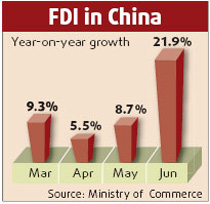According to a Xinhuanet report, the Securities Commission of Malaysia shut down a newly launched website set up by Swiss Mutual Fund (SMF) on September 15, charging that it was engaged in illegal fundraising activities.
On the same day, tens of thousands of Chinese SMF investors' desperate hopes for the reopening of SMF's website ended when they finally realized that the fund was a con scheme and that their money was gone forever. They began reporting the fraud to the authorities. Now, the State Administration for Commerce and Industry and the Ministry of Public Security are currently investigating the case.
As early as this May, a Chinese surnamed Dong in Tai'an of east China's Shandong Province reported to the local industry and commerce administration that Wei Lixin, a sales agent, had persuaded him to buy into SMF. But Wei had disappeared and Dong could not cash in his funds.
Talking with Dong, government officials found out that SMF promised a 300 percent return, a rate too good to be true. According to Dong, Wei coaxed him into investing 8,000 yuan (US$1065) into the fund by pledging a gain of 400,000 yuan (US$ 53,266) in 30 months. If Dong persuaded others to buy into the fund, he would get a 10 percent cut from each one's investment, Wei had promised.
A special team was formed to investigate the case. They found out that SMF was not registered with the China Securities Regulatory Commission, or the Ministry of Civil Affairs, or the People's Bank of China. Thus the fund was an illegal, underground scam. Analyzing how the fund worked, the team concluded that SMF was a pyramid scheme by nature that operated online in the disguise of an international fund. SMF's strategy was to defraud investors out of money by promising high returns.
On June 10, the police in Tai'an took Wei Lixin and her accomplice, Chen Yong, into custody. Afterwards, considerable evidence was produced, pointing out their unlawful activities in running the fake fund.
According to the People's Daily story, Wei and Chen confessed that SMF attracted at least 170,000 investors in China, and cajoled no less than 1.3 billion yuan (US$173 million) out of these people. The story also viewed the case as the biggest online pyramid scheme to date in terms of the quantities of people and money involved.
SMF was introduced to China early this year. The "fund" rapidly garnered fame for its high rate of return – 300 percent and established a large number of believers. Relatives or friends who guaranteed the profitability and vowed to take any responsibility often brought in new investors in the fund. This made the bogus fund appear very real to other investors.
After buying SMF, an account along with a password would be given to each investor. He or she could log onto SMF's official website to check losses and gains of the non-existent fund. Before the website was closed on August 18, it had more than 200,000 views per day. Actually, investors could get returns – not from so-called SMF turnover – but from the new investors' money. Greedy, they immediately bought more funds. Significantly, the investors could not make any deal through their online accounts at the SMF website.
In fact, the SMF has already been identified as fraudulent in other countries and regions. On April 19, 2007, Malaysia's Securities Commission and banks warned Malaysian investors against SMF. They also advised those who fell into the trap to report the fraud. Moreover, the Swiss Embassy and consulates in Malaysia and Singapore stated that it was illegal for SMF to use "Swiss" in its trademark: the fund was not registered in Switzerland. Earlier Malaysia's biggest bank, Maybank, upon discovering that SMF had used "MayBank2U.com" as a trademark in its brochures, announced that the bank had no business relations whatsoever with SMF. The Securities and Futures Commission of Hong Kong issued a notice on its website this June, saying that the SMF's website was fraudulent and also warned investors of four SMF-related websites.
Additionally, before Chinese authorities actually intervened in the SMF case, some IT professionals discovered that the SMF's website was a virtual host: this was very abnormal, seeing that the fund had claimed a 60-year history. They also discovered that SMF had transferred money not directly through bank accounts but via an intermediary service, or network payment system (NPS). In other words, SMF did not dare to use bank services like other normal funds.
(China.org.cn by Pang Li, September 27, 2007)


